| ________________
CM . . .
. Volume XVI Number 39. . . .June 11, 2010 
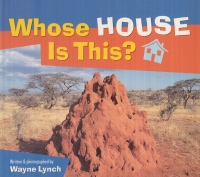 |
Whose House Is This?
Wayne Lynch.
Vancouver, BC: Whitecap Books, 1999.
30 pp., pbk., $8.95.
ISBN 978-1-55110-861-2.
Subject Heading:
Animals-Habitations-Juvenile literature.
Preschool-grade 4 / Ages 4-9.
Review by Mary Thomas.
****/4
|
| |
|
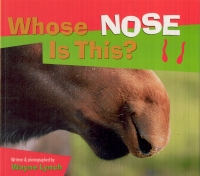 |
Whose Teeth are These?
Wayne Lynch.
Vancouver, BC: Whitecap Books, 2001.
30 pp., pbk., $8.95.
ISBN 978-1-55285-204-0.
Subject Heading:
Teeth-Juvenile literature.
Preschool-grade 4 / Ages 4-9.
Review by Mary Thomas.
****/4
|
| |
|
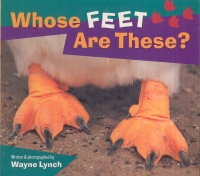 |
Whose Nose is This?
Wayne Lynch.
Vancouver, BC: Whitecap Books, 2001.
30 pp., pbk., $8.95.
ISBN 978-1-55285-174-6.
Subject Heading:
Animals-Identification-Juvenile literature.
Preschool-grade 4 / Ages 4-9.
Review by Mary Thomas.
****/4
|
| |
|
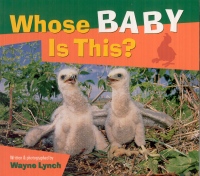 |
Whose Feet are These?
Wayne Lynch.
Vancouver, BC: Whitecap Books, 1999.
30 pp., pbk., $8.95.
ISBN 978-1-55110-860-5.
Subject Heading:
Animals-Identification-Juvenile literature.
Preschool-grade 4 / Ages 4-9.
Review by Mary Thomas.
****/4
|
| |
|
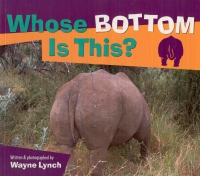 |
Whose Baby is This?
Wayne Lynch.
Vancouver, BC: Whitecap Books, 2000.
30 pp., pbk., $8.95.
ISBN 978-1-55285-064-0.
Subject Heading:
Animals-Infancy-Juvenile literature.
Preschool-grade 4 / Ages 4-9.
Review by Mary Thomas.
****/4
|
| |
|

excerpt:
I use my droopy, fuzzy nose to sniff twigs, leaves, and other plants to decide if I want to eat them. In the summer, I like to swim in deep lakes to escape from biting mosquitoes and blackflies. In the water, I can stay cool, and I can also dive for salty water lilies and other underwater plants--some of my favorite foods.
Who am I?
[following page]
I am a moose, and I live in the northern forests of North America, Europe, and Russia. I am the largest deer in the world. My shoulders are taller than those of a horse.
In winter, I use my long legs to wade through deep snow. Hungry wolves sometimes try to attack me, but I use my sharp front hooves to defend myself.
[In side box]
The huge antlers on a bull moose fall off in winter, and a new set grows each summer. (From Whose Nose is This?)
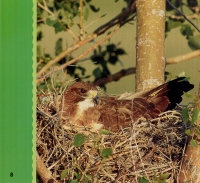 At seven creatures per book, this six-volume series of “Whose ... is/are this/these?” covers a lot of territory, both literally as it describes the feet of the penguin in Antarctica and the ptarmigan in the North, touching on all the continents in between, and figuratively. Tiny opossum babies, wobbly elephant seal noses, diamondback rattler's fangs, and ducks' tails all feature on dual pairs of pages. The first of the pair shows the nose, teeth, or whatever, of the animal in question very close-up and with some textual details to help the reader identify just 'who?' this might be. The second pair shows the whole animal (mammal, bird or reptile) in its natural surroundings with additional descriptive text. The initial enlarged picture, while not giving away the puzzle, does show enough detail that At seven creatures per book, this six-volume series of “Whose ... is/are this/these?” covers a lot of territory, both literally as it describes the feet of the penguin in Antarctica and the ptarmigan in the North, touching on all the continents in between, and figuratively. Tiny opossum babies, wobbly elephant seal noses, diamondback rattler's fangs, and ducks' tails all feature on dual pairs of pages. The first of the pair shows the nose, teeth, or whatever, of the animal in question very close-up and with some textual details to help the reader identify just 'who?' this might be. The second pair shows the whole animal (mammal, bird or reptile) in its natural surroundings with additional descriptive text. The initial enlarged picture, while not giving away the puzzle, does show enough detail that 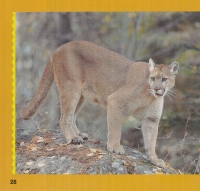 the feet, for example, do look like feet, and not just a collection of toe nails, while the accompanying text notes distinctive characteristics. I had no idea that the whisker spots on a lion's upper lip were as unique to that specific lion as our fingerprints are to us. These unusual tidbits of information could provide that extra 'something' that a school project on an animal frequently lacks, and the index in each book would help to locate the animal. An index for the whole series would be helpful, but given that the books were individually published from 1999 to 2001, it is not surprising that one does not exist. If the books were to be re-issued, such a cumulative index should be considered. the feet, for example, do look like feet, and not just a collection of toe nails, while the accompanying text notes distinctive characteristics. I had no idea that the whisker spots on a lion's upper lip were as unique to that specific lion as our fingerprints are to us. These unusual tidbits of information could provide that extra 'something' that a school project on an animal frequently lacks, and the index in each book would help to locate the animal. An index for the whole series would be helpful, but given that the books were individually published from 1999 to 2001, it is not surprising that one does not exist. If the books were to be re-issued, such a cumulative index should be considered.
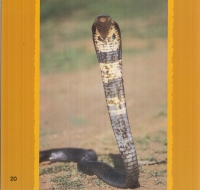 Given the number of species inhabiting the earth, even if you don't include fish and insects, it is good that the selection of creatures in the various books overlaps only very slightly. In fact, only the porcupine turns up in two books (Whose Bottom Is This? and Whose Feet Are These?) although there are two sorts of seal and two very different varieties of penguin represented. Beavers' teeth are there in all their large and orange splendor (in Whose Teeth Are These?, naturally!), and their houses are also featured, but as lodgings for otters once the beavers have moved on. So, the house is a beaver's, but the facts are about otters, and, therefore, there really is not an overlap. Given the number of species inhabiting the earth, even if you don't include fish and insects, it is good that the selection of creatures in the various books overlaps only very slightly. In fact, only the porcupine turns up in two books (Whose Bottom Is This? and Whose Feet Are These?) although there are two sorts of seal and two very different varieties of penguin represented. Beavers' teeth are there in all their large and orange splendor (in Whose Teeth Are These?, naturally!), and their houses are also featured, but as lodgings for otters once the beavers have moved on. So, the house is a beaver's, but the facts are about otters, and, therefore, there really is not an overlap.
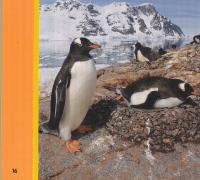 There is a preponderance of North American animals, not surprisingly, but more surprisingly very few from Europe and continental Asia. (The moose, above, and the fox are exceptions to this tendency.) It appears that examples of 'ordinary' animals are sourced locally, and 'exotic' ones taken from the fauna of Africa, Australia, and South America. This is not a bad thing--I dislike it when children are unable to identify foxes and deer but can immediately name giraffes, elephants, and zebras. There is a preponderance of North American animals, not surprisingly, but more surprisingly very few from Europe and continental Asia. (The moose, above, and the fox are exceptions to this tendency.) It appears that examples of 'ordinary' animals are sourced locally, and 'exotic' ones taken from the fauna of Africa, Australia, and South America. This is not a bad thing--I dislike it when children are unable to identify foxes and deer but can immediately name giraffes, elephants, and zebras.
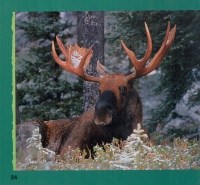 In fact, I found the books excellent in almost all aspects. The illustrations are good clear photographs, the text is informative without being pedantic, and the riddle format tantalizing. They would be perfect for sharing with a child who had just reached that fact-hungry stage where curiosity is endless and wanting satisfaction. I could wish for just a few more really common creatures--mice and rabbits, or even cats or dogs--and fewer of the foreign exotics, but I confess I also had hopes of a good view of a mandrill's really spectacular red-and-blue posterior! The kids won't care, however; they'll just enjoy. In fact, I found the books excellent in almost all aspects. The illustrations are good clear photographs, the text is informative without being pedantic, and the riddle format tantalizing. They would be perfect for sharing with a child who had just reached that fact-hungry stage where curiosity is endless and wanting satisfaction. I could wish for just a few more really common creatures--mice and rabbits, or even cats or dogs--and fewer of the foreign exotics, but I confess I also had hopes of a good view of a mandrill's really spectacular red-and-blue posterior! The kids won't care, however; they'll just enjoy.
Highly Recommended.
Mary Thomas works in an elementary school in Winnipeg, MB, and realizes that there are some children who just don't like fiction (although she doesn't understand the attitude!).

To comment
on this title or this review, send mail to cm@umanitoba.ca.
Copyright © the Manitoba Library Association. Reproduction for personal
use is permitted only if this copyright notice is maintained. Any
other reproduction is prohibited without permission.
NEXT REVIEW |
TABLE OF CONTENTS FOR THIS ISSUE- June 12, 2009.
AUTHORS |
TITLES |
MEDIA REVIEWS |
PROFILES |
BACK ISSUES |
SEARCH |
CMARCHIVE |
HOME |





 At seven creatures per book, this six-volume series of “Whose ... is/are this/these?” covers a lot of territory, both literally as it describes the feet of the penguin in Antarctica and the ptarmigan in the North, touching on all the continents in between, and figuratively. Tiny opossum babies, wobbly elephant seal noses, diamondback rattler's fangs, and ducks' tails all feature on dual pairs of pages. The first of the pair shows the nose, teeth, or whatever, of the animal in question very close-up and with some textual details to help the reader identify just 'who?' this might be. The second pair shows the whole animal (mammal, bird or reptile) in its natural surroundings with additional descriptive text. The initial enlarged picture, while not giving away the puzzle, does show enough detail that
At seven creatures per book, this six-volume series of “Whose ... is/are this/these?” covers a lot of territory, both literally as it describes the feet of the penguin in Antarctica and the ptarmigan in the North, touching on all the continents in between, and figuratively. Tiny opossum babies, wobbly elephant seal noses, diamondback rattler's fangs, and ducks' tails all feature on dual pairs of pages. The first of the pair shows the nose, teeth, or whatever, of the animal in question very close-up and with some textual details to help the reader identify just 'who?' this might be. The second pair shows the whole animal (mammal, bird or reptile) in its natural surroundings with additional descriptive text. The initial enlarged picture, while not giving away the puzzle, does show enough detail that  the feet, for example, do look like feet, and not just a collection of toe nails, while the accompanying text notes distinctive characteristics. I had no idea that the whisker spots on a lion's upper lip were as unique to that specific lion as our fingerprints are to us. These unusual tidbits of information could provide that extra 'something' that a school project on an animal frequently lacks, and the index in each book would help to locate the animal. An index for the whole series would be helpful, but given that the books were individually published from 1999 to 2001, it is not surprising that one does not exist. If the books were to be re-issued, such a cumulative index should be considered.
the feet, for example, do look like feet, and not just a collection of toe nails, while the accompanying text notes distinctive characteristics. I had no idea that the whisker spots on a lion's upper lip were as unique to that specific lion as our fingerprints are to us. These unusual tidbits of information could provide that extra 'something' that a school project on an animal frequently lacks, and the index in each book would help to locate the animal. An index for the whole series would be helpful, but given that the books were individually published from 1999 to 2001, it is not surprising that one does not exist. If the books were to be re-issued, such a cumulative index should be considered. Given the number of species inhabiting the earth, even if you don't include fish and insects, it is good that the selection of creatures in the various books overlaps only very slightly. In fact, only the porcupine turns up in two books (Whose Bottom Is This? and Whose Feet Are These?) although there are two sorts of seal and two very different varieties of penguin represented. Beavers' teeth are there in all their large and orange splendor (in Whose Teeth Are These?, naturally!), and their houses are also featured, but as lodgings for otters once the beavers have moved on. So, the house is a beaver's, but the facts are about otters, and, therefore, there really is not an overlap.
Given the number of species inhabiting the earth, even if you don't include fish and insects, it is good that the selection of creatures in the various books overlaps only very slightly. In fact, only the porcupine turns up in two books (Whose Bottom Is This? and Whose Feet Are These?) although there are two sorts of seal and two very different varieties of penguin represented. Beavers' teeth are there in all their large and orange splendor (in Whose Teeth Are These?, naturally!), and their houses are also featured, but as lodgings for otters once the beavers have moved on. So, the house is a beaver's, but the facts are about otters, and, therefore, there really is not an overlap.  There is a preponderance of North American animals, not surprisingly, but more surprisingly very few from Europe and continental Asia. (The moose, above, and the fox are exceptions to this tendency.) It appears that examples of 'ordinary' animals are sourced locally, and 'exotic' ones taken from the fauna of Africa, Australia, and South America. This is not a bad thing--I dislike it when children are unable to identify foxes and deer but can immediately name giraffes, elephants, and zebras.
There is a preponderance of North American animals, not surprisingly, but more surprisingly very few from Europe and continental Asia. (The moose, above, and the fox are exceptions to this tendency.) It appears that examples of 'ordinary' animals are sourced locally, and 'exotic' ones taken from the fauna of Africa, Australia, and South America. This is not a bad thing--I dislike it when children are unable to identify foxes and deer but can immediately name giraffes, elephants, and zebras.  In fact, I found the books excellent in almost all aspects. The illustrations are good clear photographs, the text is informative without being pedantic, and the riddle format tantalizing. They would be perfect for sharing with a child who had just reached that fact-hungry stage where curiosity is endless and wanting satisfaction. I could wish for just a few more really common creatures--mice and rabbits, or even cats or dogs--and fewer of the foreign exotics, but I confess I also had hopes of a good view of a mandrill's really spectacular red-and-blue posterior! The kids won't care, however; they'll just enjoy.
In fact, I found the books excellent in almost all aspects. The illustrations are good clear photographs, the text is informative without being pedantic, and the riddle format tantalizing. They would be perfect for sharing with a child who had just reached that fact-hungry stage where curiosity is endless and wanting satisfaction. I could wish for just a few more really common creatures--mice and rabbits, or even cats or dogs--and fewer of the foreign exotics, but I confess I also had hopes of a good view of a mandrill's really spectacular red-and-blue posterior! The kids won't care, however; they'll just enjoy.